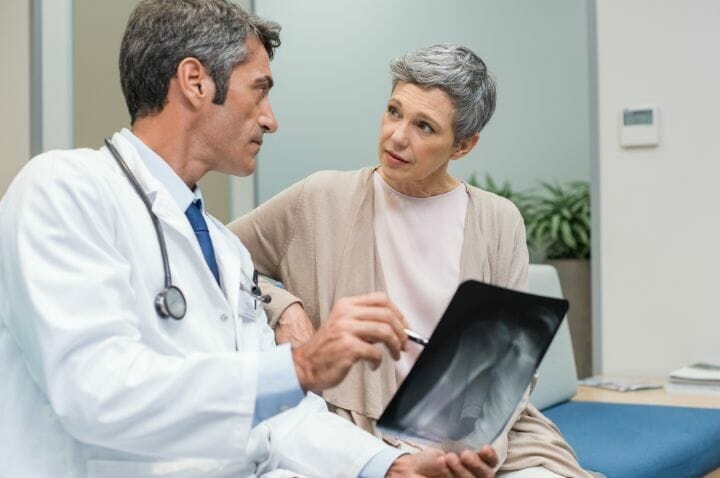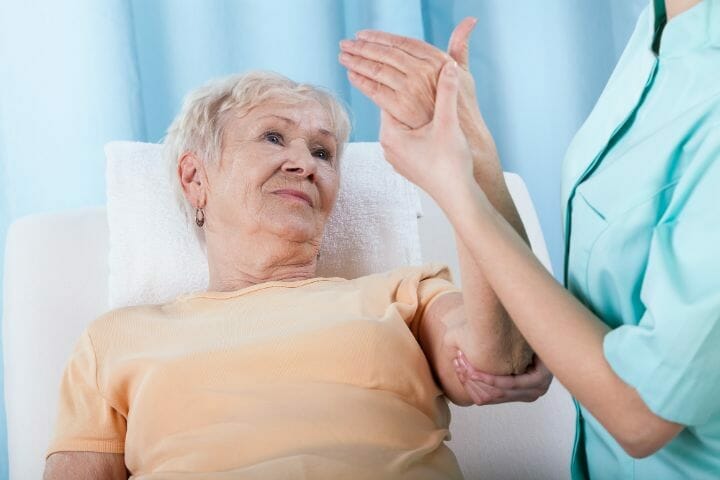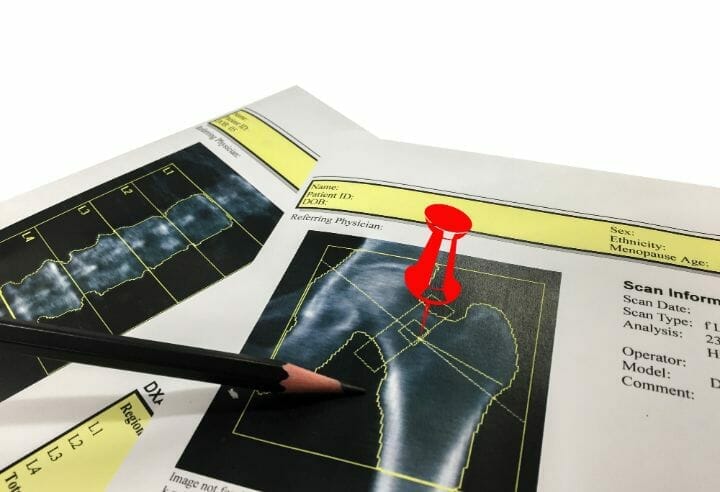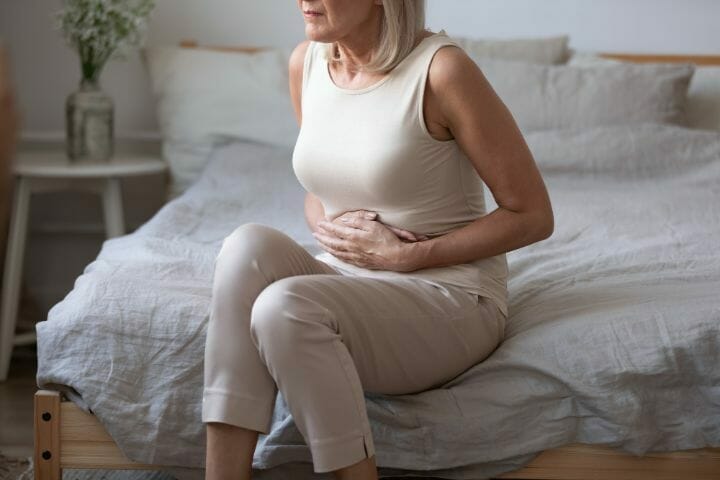Osteoporosis is a condition that affects millions of people around the globe. It causes the bones to become weak and brittle. Our bones are living tissues that are repeatedly remodeled which means they are constantly broken down and replaced.

In a person with osteoporosis, the rate of new bone formation is slower than the rate at which the bone loss occurs, leading to bone thinning. This bone-thinning makes a person more susceptible to bone fractures. In fact, in severe cases of osteoporosis, the bones become so brittle that even a small fall or everyday actions, such as bending or even a violent sneeze, can cause vertebral fractures.
The bone is like a honeycomb structure with many small spaces. When a person has osteoporosis, these small spaces increase in size, reducing bone strength. Though osteoporosis affects people across all races and genders, Caucasian and Asian postmenopausal women are shown to be at the highest risk.
During the prime of your youth, that is, in your early twenties, this remodeling process slows down, and most individuals attain their peak bone mass by the age of thirty.
The possibility of developing osteoporosis depends partially on how much bone mass you build during your young age. Peak bone mass is genetic and varies by ethnicity. The more the peak bone mass, the slighter your likelihood of developing osteoporosis.
Vitamin D and Calcium supplements for bone health, good nutrition, lifestyle changes, and weight-bearing exercise can help slow down bone loss, strengthen weak bones, and maintain bone health.
Contents
Factors That Increase Osteoporosis Development
Several factors can increase the chances of osteoporosis development and adversely affect bone health. These factors include age, race, lifestyle choices, and certain diseases and treatments. Some risk factors for osteoporosis are genetic or innate. These can include:
Gender
Osteoporosis is a disease that can occur in both men and women, but it affects more women than men. Women are more likely to develop osteoporosis because they start with a low mineral density of the bone. In addition, women are more likely than men to get osteoporosis because they lose bone density after menopause, while men do not have this risk factor.
It is estimated by the NOF ( National Osteoporosis Foundation) that there are around 26 million women with low bone mass and 9.1 million with osteoporosis. In contrast, there are an estimated 14.5 million men with low bone mass and 2.8 with osteoporosis [1].
Age
Osteoporosis becomes more prevalent with age because the production of certain hormones slows down as we get older. This means less bone-building calcium in your body, which leads to weak bones and an increased chance of breaking them. However, osteoporosis is not just an older person’s disease; it can affect people from all walks of life at any stage in their lives, though it is nowhere near as widespread as in the elderly.
Race
Osteoporosis can affect people of all races, but it may be more prevalent in certain ethnic groups. The race might affect osteoporosis rates due to different ethnicities having different genetic backgrounds that could contribute or protect them from developing the condition. It is more prevalent among Caucasians than African Americans or Hispanics because it has been shown that Caucasian people have less bone density than their counterparts. Those of Asian descent also have an increased risk of developing osteoporosis because they tend to have thinner, lighter bone density than other races.
Family history
If a person has parents or grandparents who had or currently have the disease, their chances of developing osteoporosis increase. Heredity plays an important role in how our bodies process calcium and other minerals important for bone health. Individuals with a genetic predisposition for osteoporosis should be aware of this so they can make lifestyle changes accordingly in order to reduce the rate of bone loss as they get older.
Other risk factors can include:
- Hormone levels in the body: Osteoporosis is more commonly seen in people with an imbalance of sex hormones, thyroid hormones, or adrenal glands in their bodies. There are enough studies proving that estrogen deficiency and osteoporosis have a high correlation.
- Dietary factors and lifestyle: For people who are deficient in calcium and Vitamin D and suffer from eating disorders, or recent gastrointestinal surgery, the risk of osteoporosis is higher. A sedentary lifestyle, excessive alcohol consumption, and smoking can cause osteoporosis.
- Steroids and other medications: Long-term use of medications like oral or injected corticosteroids (prednisone and cortisone) may cause osteoporosis. These drugs interfere with the process of bone rebuilding. The risk factor of osteoporosis is also high with prolonged use of drugs like antiepileptics, antacids, chemotherapy, and immunosuppressants.
- Medical conditions: The risk of osteoporosis is elevated in people suffering from some medical issues like gastrointestinal issues like Celiac disease, inflammatory bowel disease, kidney or liver disease, cancer, Lupus, and rheumatoid arthritis.
You may also like The Difference Between Osteoarthritis and Osteoporosis
Estrogen Deficiency and Osteoporosis
Estrogen has a vital role in bone health and growth and the maintenance of balance during bone remodeling. It is a bit complex to comprehend the exact manner by which estrogen affects osteoporosis. Studies have shown that estrogen helps maintain bone homeostasis, i.e., a state of balance through the regulatory effect on the body’s immune system, directly impacting bone cells. Simply put, estrogen keeps bone metabolism in check. Curbing obesity; a risk factor for osteoporosis.
Estrogen has some direct effects on the metabolism of bone and bone mineral density. It stops the activation of bone remodeling and the initiation of new basic multicellular units. It also plays a role in decreasing bone resorption. Estrogen stimulates the differentiation of bone-forming cells called osteoblasts and prevents their death.
Interaction of estrogens with the receptors in target cells of bone and other tissues regulates bone growth, bone development as well as bone strength, acquisition of bone metabolism peak bone mass, inhibition of bone loss, and bone metabolism. The gene encoding estrogen receptor 1 (ESR-1) is an essential component for determining the risk of osteoporosis.
The lack of estrogen receptors in osteoblast progenitor (origin cells) and precursor cells affects the protective layer of the bone. On the other hand, the absence of these receptors in differentiated osteoblasts, osteocytes, and osteoclasts causes reduced cancellous bone mass.
Another factor is RANKL (receptor activator of nuclear factor–kappa B), a biochemical molecule of an enzyme.
RANKL is associated with bone turnover remodeling. RANKL is released by the bone-forming cells and stimulates the ligand, RANK, on the stem cell surface to form bone resorption cells. Also, when RANK is released from osteoclasts, it promotes bone formation. It plays an important role in combating the excessive bone resorption caused by osteoporosis.
Hence with proper estrogen levels, you can ensure that bone formation is balanced at the cellular level.
Estrogen Deficiency in Men
Osteoporosis is often seen as a disease related to women, but recent studies show that it can also affect men. An article published by the Journal of Clinical Endocrinology and Metabolism [2] discussed an increase in bone loss in elderly men due to estrogen deficiency. The research shows that elderly males with low levels of estrogen are more likely to develop osteoporosis than those who have higher levels. Low estrogen has been associated with age-related metabolic declines, such as declining testosterone production.
The condition is often overlooked in elderly males due to a lack of awareness or early symptoms that often mimic more common conditions such as arthritis. However, it can lead to serious complications like hip fractures if left untreated for a long period of time.
Postmenopausal Osteoporosis in Older Women
Most women experience classic menopausal symptoms like hot flashes, mood swings, and irritability during menopause. This is due to a sudden drop in estrogen.
On the other hand, a menopausal woman cannot ascertain any evident changes to her bone health. It is the major reason why postmenopausal bone loss goes undetected in many cases.
Estrogen deficiency (especially in post-menopausal women) speeds up bone destruction. This phase in a post-menopausal woman leads to an increase in loss of bone tissue, causing postmenopausal osteoporosis.
Postmenopausal osteoporosis (Type I osteoporosis) generally develops after menopause, when estrogen levels drop steeply. This estrogen deficiency leads to bone loss.
Initially, bone loss can be primarily found in the trabecular bone during the start of menopause.
Studies reveal that women lose about 50% of their trabecular bone and 30% of their cortical bone during their lifetime. About half of the bone loss occurs during the first ten years after menopause.
Estrogen deficiency after menopause is the cause for accelerated bone loss in women, with a yearly postmenopausal bone loss rate of 3% to 5% for five to ten years.
You may also like Intermittent Fasting and Osteoporosis
Factors That Determine Severity of Osteoporosis in Postmenopausal Women:
- Genetic factors
- Physical activity
- Nutrition
- Smoking
- Body mass index
- Concurrent disorders and medications
- Age
These factors modulate the onset and the severity of postmenopausal osteoporosis.
Bodyweight and fat stores play an essential role in estrogen release and the onset of postmenopausal osteoporosis. The effect of the amount of fat mass and estrogen on bone mineral density is explained by the fact that residual estrogens are produced by converting adrenal androgens by an enzyme called aromatase, which is highly expressed in white adipose tissue.
Obese women tend to have higher circulating estrogen levels (especially after menopause) than their age-matched counterparts with a normal BMI.
Estrogen also has an indirect positive effect on calcium metabolism. Estrogen deficiency reduces both intestinal and renal calcium absorption.
Osteoporosis Prevention and Treatment
Measures to prevent osteoporosis are best initiated before you attain peak bone mass. Primary prevention of osteoporosis is generally recommended to all women, especially to those identified as being at an increased risk. Good nutrition and regular exercise are inevitable.
Calcium and Vitamin Supplementation
Dairy products are the best calcium sources due to their high elemental calcium content, high absorptive rate, and relatively low cost. Dietary sources of calcium are milk/dairy products and a few green vegetables. Adequate calcium intake can be achieved by taking calcium supplements, which are easily available. By the way, we have a separate article on diet plans for osteoporosis.
The most common calcium supplements are calcium citrate and calcium carbonate. Both supplements are equally absorbed when taken with food.
Many people are unaware that vitamin D is essential for bone growth and is a key player in helping prevent osteoporosis. Although it can be obtained from sunlight and food sources such as milk, eggs, and leafy greens, it can be hard to get enough through diet alone in many cases, so supplementation is a good option. Vitamin D deficiency often goes unnoticed because symptoms may not manifest until years after deficiencies exist. Hence, people with osteoporosis need to be aware of their vitamin D levels. You can always speak to your doctor about being tested for low vitamin D levels.
Exercise to Prevent Loss of Bone Density
To help build normal bone density and reduce the chance of osteoporotic fractures, you should aim to engage in physical activity a few times a week. Yoga for osteoporosis is an exercise routine that helps strengthen muscles and increase bone density. It also improves balance, flexibility, and coordination.
In addition, try weight-bearing exercises that help build bone density, such as walking with a weighted vest for osteoporosis. There are plenty of other exercises for bone health, for instance, isometric exercises and resistance exercises that will prevent the risk of fractures. You don’t have to go to the gym or invest in exercise equipment if you don’t want to; dancing or climbing the stairs a few times a day will help.
Estrogen Replacement Therapy
Estrogen replacement therapy is a widely accepted treatment of osteoporosis. This estrogen treatment has visible benefits on symptoms and improves the quality of the patient’s life.
Treating osteoporosis with hormone replacement therapy decreases future bone fracture risk and complications.
Estrogen replacement is a popular approach in premenopausal as well as postmenopausal women. Hormone replacement therapy has shown to be very effective for osteoporosis prevention in women before the age of 60 years or within ten years post-menopause. It is also recommended for the management of osteoporosis in elderly women.
However, after 60, estrogen therapy for fracture prevention is not recommended since it carries the risk of long-term complications like breast cancer. The protective shield of hormone replacement therapy on bone mineral density decreases at an unpredictable rate after stopping the therapy;
Hormone replacement therapy can help preserve and stimulate the growth of bone mass density (especially on the lumbar spine and femoral neck).
Side-Effects of Estrogen Replacement Therapy
Some of the adverse effects of estrogen replacement may include:
- Breast enlargement and tenderness
- Bleeding
- Leg cramps
- Upset stomach upset
- Nausea
Exclusive estrogen replacement (hormone therapy) is also said to increase breast cancer risk, but only when used for more than ten years.
Due to the mechanisms of action of estrogen therapy or selective estrogen receptor modulators application, the genetic variability in the ESR1 gene has important pharmacogenetic implications. Hormone therapy is a treatment commonly used to relieve symptoms of osteoporosis.
Exogenous estrogen types are also primary osteoporosis prevention in postmenopausal women, as these drugs reduce the risk of vertebral and hip fractures. Selective estrogen receptor modulators are used to prevent and treat osteoporosis and breast cancer prevention in high-risk postmenopausal women with osteoporosis.
A drug, raloxifene, is a type of selective estrogen receptor modulator that mimics estrogen’s action on the skeletal system by binding to estrogen receptors. This drug prevents adverse effects on the breast and endometrium. In addition to estrogen therapy and selective estrogen receptor modulators, other approved therapies for osteoporosis are bisphosphonates, application of vitamin D derivates, parathyroid hormone, calcitonin, and anti-RANK ligand monoclonal antibodies.
Many women discontinue the standard dose of estrogen replacement (hormone therapy) due to its side effects and eventually lose the bone sparing effects. The strategy, however, is to maintain the protective effect of estrogen on the bone for the long term and continue the timely reduction of estrogen replacement dosage.
Several drugs in the market reduce the risk by decelerating bone resorption, for example, bisphosphonates and denosumab, or some drugs stimulate bone formation like teriparatide.
Osteoporosis can also be seen in young women, especially during pregnancy and breastfeeding. In premenopausal women with irregular or absent menstrual cycles, estrogen production might be lower than desired. Doctors recommend estrogen supplementation to combat estrogen deficiency and side effects.
Osteoporosis is a silent disease that also affects men. It can be seen in men battling prostate cancer. The majority of the men who are diagnosed with prostate cancer are sixty-five years or older. As men age, their risk for osteoporosis increases. Many studies have demonstrated that men who get administrated hormone deprivation therapy, also called androgen suppression therapy for prostate cancer, are at an escalated risk of developing osteoporosis. Androgens such as testosterone protect men against bone loss. So, once these hormones are suppressed, the bone becomes less dense and can break more easily.
In Conclusion
As explained throughout the article, the estrogen hormone is essential for bone loss prevention.
Estrogen is a hormone that regulates many different functions in the body. It helps regulate menstruation and reproduction, but it also affects bone density and heart health. Estrogen deficiency can have serious adverse effects on your health, physically and mentally; it can cause mood swings and sleep issues. The good news is some treatments help alleviate the symptoms of estrogen deficiency, such as hormone replacement therapy and diet and lifestyle modifications.
We recommend that you speak with your doctor to chart out the best course of treatment for maintaining bone density and enhancing bone health.





